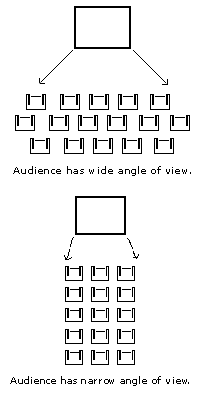Step Two - Selecting a Screen Surface
The way a screen surface refracts light is what differentiates one screen fabric from another. Manufacturers specify both gain and viewing angle to help you decide which surface is best for you. Take some time to think about the following questions before making your final decision.
Does your viewing area have controlled lighting or ambient light?
Does the space where you plan to use your screen have controlled lighting? Or is there ambient light from windows and office/household lighting? Your screen material can help minimize the effects of ambient light in rooms without controlled lighting. Screen materials can also help to increase the appearance of contrast or brightness of a projected image.
For bright rooms with lots of ambient light, we recommend Screen Innovations Black Diamond screen .
What is the room configuration?
In rooms that are wider than they are deep, some audience members may find themselves at an angle to the screen where "fall-off" occurs, making it difficult for them to see the image. In these situations, a screen surface with a larger viewing angle is preferred. Longer rooms may require larger screens so that those in the back of the room can clearly see the display's details.
What type of images do you intend to display?
The content you display on your screen will also play a part in determining which screen is best for you. Gray screen material is popular with home theater enthusiasts because the material adds the appearance of contrast to a video image. This effect is most prominent on projectors with a 2,000:1 or lower contrast ratio. White or matte white screens are more popular in business applications. In situations where accurate color is desired, such as viewing digital photography, a white or matte white surface will provide truer color representation.

| Common Applications | Screen Surface Suggestions |
|---|---|
| Video (TV, Blu-ray or DVD sources) | gray, white or matte white |
| Digital photography | white or matte white |
| Computer images | white or matte white |
| Detailed spreadsheets or CAD designs (high-res, high detail) | white or matte white |
